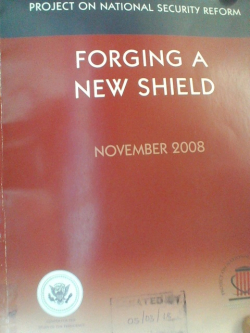Forging A New Shield / Project On National Security Reform.

Book Stores
Type
Book
Category
355-Military Science
[ Browse Items ]
Publication Year
2008
Publisher
PNSR, United States
Pages
702
Subject
Project on National Security Reform; National security -- United States; Civil defense -- United States; Emergency management -- United States; Interagency coordination -- United States; Organizational change -- United States
Abstract
The legacy structures and processes of a national security system that is now more than 60 years old no longer help American leaders to formulate coherent national strategy. 1. The system is grossly imbalanced. It supports strong departmental capabilities at the expense of integrating mechanisms. 2. Resources allocated to departments and agencies are shaped by their narrowly defined core mandates rather than broader national missions. 3. The need for presidential integration to compensate for the systemic inability to adequately integrate or resource missions overly centralizes issue management and overburdens the White House. 4. A burdened White House cannot manage the national security system as a whole to be agile and collaborative at any time, but it is particularly vulnerable to breakdown during the protracted transition periods between administrations. 5. Congress provides resources and conducts oversight in ways that reinforce the first four problems and make improving performance extremely difficult. Taken together, the basic deficiency of the current national security system is that parochial departmental and agency interests, reinforced by Congress, paralyze interagency cooperation even as the variety, speed, and complexity of emerging security issues prevent the White House from effectively controlling the system. The White House bottleneck, in particular, prevents the system from reliably marshaling the needed but disparate skills and expertise from wherever they may be found in government, and from providing the resources to match the skills. That bottleneck, in short, makes it all but impossible to bring human and material assets together into a coherent operational ensemble. Moreover, because an excessively hierarchical national security system does not know what it knows as a whole, it also cannot achieve the necessary unity of effort and command to exploit opportunities.
Biblio Notes
CONTENTS
PART I: INTRODUCTION …………………………………….................…....p. 1
A. Overview of the project on National Security Reform ……….p. 3
B. Reform Trends ……………………………………………......................p. 7
PART II: DESCRIPTION AND HISTORIAL BACKGROUND OF
THE SYSTEM ………………………………………………………........................P. 19
A. Components Of The National Security System ……….………...P. 21
B. History Of The National Security System ………………….......…P. 43
Part II: Assessment Of System Performance ………....................P. 83
A. Performance Criteria ………………………………………….............….P. 85
B. Performance To Date …………………………………………….............P. 91
C. Overarching Explanation For Current System Performance P. 118
D. Future Performance ……………………………………………...............P. 162
PART IV: PROBLEM ANALYSIS OF THECURRENT SYSTEM …........P. 169
A. Missing Prerequisites For Strategic Direction …………………….P. 170
B. Structure …………………………………………………………..................P. 181
C. Process …………………………………………………………..................…P. 221
D. Human Capital ……………………………………………………...............P. 260
E. Knowledge Management …………………………………………...........P. 290
F. Resources Management ………………………………………............…P. 323
G. Congress’s Role And Effective Oversight …………………………...P. 351
H. Conclusions: Underlying Assumptions Of The Current System ……P. 378
PART V: ANALYSIS FOR OPTIONS FOR REFORM ………………….......P. 383
A. Introduction ………………………………………………………..............…P. 386
B. The Definition And Scope Of National Security ………………….P. 392
C. Core Reforms ………………………………………………………............…P. 397
D. Option One: White House Command ………………………………….P. 419
E. Option Two: Integrated Regional Centers ………………………….P 428
F. Option Three: A Hierarchy Of Decentralized Teams ……….…P. 440
G. Supporting Options: Structural Consolidation ……………………P. 459
H. Conclusion ……………………………………………………………..............P. 488
PART VI: CONCLUSIONS AND RECOMMENDATIONS ………………....P. 491
PART I: INTRODUCTION …………………………………….................…....p. 1
A. Overview of the project on National Security Reform ……….p. 3
B. Reform Trends ……………………………………………......................p. 7
PART II: DESCRIPTION AND HISTORIAL BACKGROUND OF
THE SYSTEM ………………………………………………………........................P. 19
A. Components Of The National Security System ……….………...P. 21
B. History Of The National Security System ………………….......…P. 43
Part II: Assessment Of System Performance ………....................P. 83
A. Performance Criteria ………………………………………….............….P. 85
B. Performance To Date …………………………………………….............P. 91
C. Overarching Explanation For Current System Performance P. 118
D. Future Performance ……………………………………………...............P. 162
PART IV: PROBLEM ANALYSIS OF THECURRENT SYSTEM …........P. 169
A. Missing Prerequisites For Strategic Direction …………………….P. 170
B. Structure …………………………………………………………..................P. 181
C. Process …………………………………………………………..................…P. 221
D. Human Capital ……………………………………………………...............P. 260
E. Knowledge Management …………………………………………...........P. 290
F. Resources Management ………………………………………............…P. 323
G. Congress’s Role And Effective Oversight …………………………...P. 351
H. Conclusions: Underlying Assumptions Of The Current System ……P. 378
PART V: ANALYSIS FOR OPTIONS FOR REFORM ………………….......P. 383
A. Introduction ………………………………………………………..............…P. 386
B. The Definition And Scope Of National Security ………………….P. 392
C. Core Reforms ………………………………………………………............…P. 397
D. Option One: White House Command ………………………………….P. 419
E. Option Two: Integrated Regional Centers ………………………….P 428
F. Option Three: A Hierarchy Of Decentralized Teams ……….…P. 440
G. Supporting Options: Structural Consolidation ……………………P. 459
H. Conclusion ……………………………………………………………..............P. 488
PART VI: CONCLUSIONS AND RECOMMENDATIONS ………………....P. 491
Number of Copies
1
| Library | Accession No | Call No | Copy No | Edition | Location | Availability |
|---|---|---|---|---|---|---|
| Main | 561 |
355.03 PRO |
1 | Yes |




